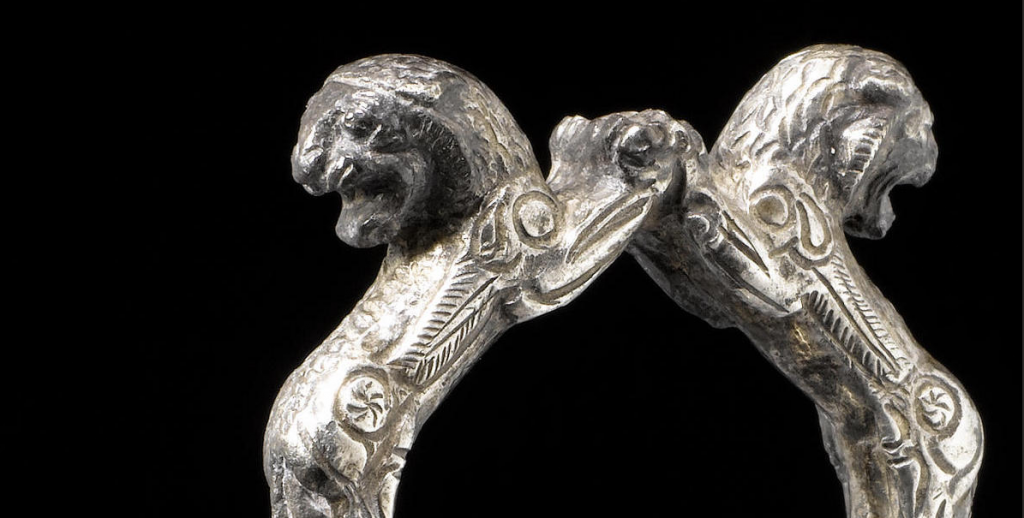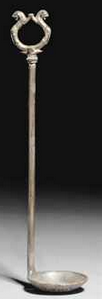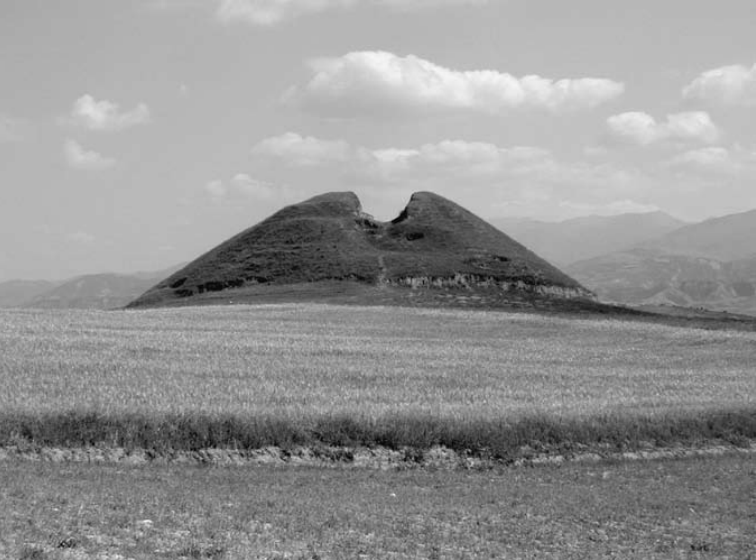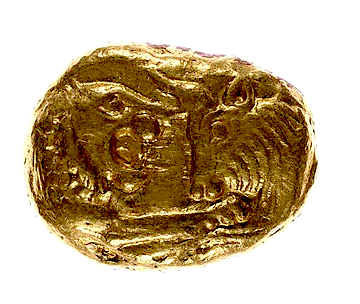The following article is written by guest contributor Saba Askary. A graduate of OCAD University (Toronto) and Christie’s Education (London), Askary has specialized in the field of Art History, and with it the concept of changing history through new interpretations. She is currently the Assistant Director of the Walnut Contemporary art gallery, Toronto.
On the afternoon of April 14th 2011, a slim and elegant twenty-five hundred year old Kyathos (meaning ‘dipper’ in Greek, a ladle in the modern sense) was sold in a London Christie’s auction room to the highest bidder. Lot 340, “An Achaemenid Silver Kyathos” went to a private buyer for £28,750 ($47,006), almost twice its highest estimated price. Behind this Kyathos lies a controversy stretching as far back as the mid-1960s and encompassing matters of looting, lawsuits, identity and heritage issues, and a convoluted case of cultural labeling that reveals the issues behind implementing a binary division between “East” and “West” on an institutional level. On April 14th, this context went unnoticed.

The kyathos had been seen on the auction market before. Four years earlier, in October 2007, it had popped up in a sales catalogue for a UK auction house called Bonhams. Registered as Lot 216, the artefact was under the same title, “An Achaemenid Silver Kyathos”. But on the morning it was meant to be sold the artefact had disappeared. It was unclear whether it had been withdrawn by the owner or the auction house. A few days before this intended sale, however, a blog post in Looting Matters by David Gill, a professor of Archaeological Heritage and Head of the Division of Humanities at University Campus Suffolk, had made things a little more complicated. Gill pointed out a rather embarrassing mistake on the part of the specialists at Bonhams. When the catalogue’s Lot Notes were looked through, they stated that another virtually identical kyathos could be found in the Metropolitan Museum of Art in New York, as seen in a catalogue bulletin called A Greek and Roman Treasury published in 1984 by Dietrich von Bothmer. The only difference was that the identical kyathos was catalogued as “Greek, 6th century.” These Lot Notes were carelessly copied into the catalogue entry in 2011 at the Christie’s sale as well.

So was the kyathos Greek as the Metropolitan suggested, or Achaemenid Persian as the auction houses suggested? Though puzzling, it is not uncommon for institutions to disagree on the cultural origin of an artefact. The problem was rather that Bonham’s information was about two decades out of date. Gill also pointed out that after losing a lawsuit in October 1993, the identical Kyathos at the Metropolitan Museum of Art, along with a large hoard of other similar artefacts, were de-accessioned and sent back to their pre-looted home in Izmir, Turkey. The Kyathos was not Greek, nor was it Achaemenid Persian, it was Lydian.
Perceptions of historical identities and present identities have always gone hand-in-hand on the basis of heritage and descent; personally, collectively, culturally, and ethnically. Artefacts that remain from these histories are not only remnants of past events and peoples, but also raw materials for potentially new projects of nation-building and identity formation, depending on how they are interpreted. There can be no doubt that the farther back cultural history stretches, the more generalisations and ambiguities result in our interpretations. The ancient Mediterranean of the 6th to 4th century BC is a particularly interesting period of identity formation; it includes the beginnings of classical and democratic Greece, the rise of the Achaemenid Persian empire (c.550-330 BC), the Greco-Persian wars (c.499-449 BC) and the so-called conception of our East-West dichotomy. Yet it is important to remember that these ideas have emerged through a long and shifting line of written histories rather than the events themselves.
This binary vision of the world and of ancient history emanates from a colonial outlook separating “civilized” and “uncivilized” populations and cultures. The origin of museum culture came out of the need to collect and document the societies that colonialists came into contact with through the platform of the 18th century European Enlightenment movement. By embracing this arbitrary division, our ability to understand the complex interconnectedness and countless linkages between cultures is put at stake, and this becomes ever more apparent the farther back we reach in history. In fact, in the past two decades, archaeological discoveries and academic research has shed light on the multi-cultural spheres between the lands of antiquated Greece and Persia that were, up until recently, wholly forgotten. The stunning craftsmanship of the Thracians in the Balkans, the nomadic Scythians around the Black Sea, and the Lydian kingdom in the heart of Anatolia have been widely acknowledged in scholarly and archaeological circles. Yet when these artefacts appear in the hands of auction houses or various museums, they are many a times slotted in this East-West master narrative and represented as emanating from one end of this polarity: either Western or Eastern, Greek or Persian. Sometimes, the tortured term “Greco-Persian,” as a formalist and epistemological study of Greek art, is also employed.
One reason behind this is the prevalence of what may be described as “museum mentality.” Geared towards didacticism, museums do not account for ambiguity, and neither is ambiguity very profitable for auction. The function and duty of which museums abide by today is to research, educate, and conserve artefacts, while presenting to the public “a demonstration of national and international, natural and cultural heritage,” as stated by the International Council of Museums. To avoid buying recently looted or fraudulent artefacts, most museums have adopted the UNESCO Convention Act concerning new acquisitions, which states that they cannot acquire new major artefacts unless a provenance (a direct line of ownership records from hand to hand) reaching back to November 14th 1970 (the date the act was signed) can be proven. However, many smaller artefacts have escaped this condition on a basis of lower significance.
The function of international auction houses dealing in antiquities is to circulate these artefacts within the buyer community for a fee and commission on the final sale. When an artefact first enters into the auction market, a specialist focusing on factors of culture, design, and provenance researches the object and draws up a catalogue entry with an estimated price range. This is then published in a sales catalogue booklet for the auction and given to potential buyers. The older the provenance of an object, and the higher they can deem its importance to cultural heritage, the higher its estimated price range can become, and the more viewers it will pull in. In effect, most museums and auction houses process antiquities on older and more established academic knowledge during their research, many times disregarding newer archeological discoveries that can change the concept of the artefact in question, and perhaps antiquity as a whole. They support a master narrative of an East/West dichotomy and allow it to remain the prevalent ideology because it makes their job simpler, even though this paradigm has been cracking for decades. Thus an ancient culture such as Lydia, one that transcends the boundaries between East and West, Persia and Greece, is subject to ambiguity. This is reflective of what can be termed “museum mentality.”

In the years between 1966 and 1970, the Greek and Roman department of the Metropolitan Museum of Art obtained what is known today as the Lydian Treasure. These came from burial mounds of Toptepe near the Gure-Uşak province, the İkiztepe Tumulus and the Aktepe I Tumulus, around what was once the kingdom of Lydia, now a part of Izmir (western Turkey). Smuggled through Switzerland and on to New York dealers, the treasure was kept under wraps until its inclusion in a 1984 blockbuster exhibition with the misleading title “East Greek Treasures” in the Metropolitan Museum of Art. By this time the Turkish government was also on the trail. Burhan Tezcan, at the time the head of Excavations and Directorate General of Antiquities in Ankara had begun discussions addressing the burial mounds and was able to detect the artefacts that were clearly taken illegally from Turkey by looters. They demanded its return, the Metropolitan refused, and in 1987 a lawsuit was filed against the museum, which the Turkish government was only able to win six years later. The Turkish authorities stated that the Metropolitan concealed the real origin of these artefacts through misrepresentation, by labeling them ‘Greek.’ The Lydian Treasure was to them “an integral and invaluable part of the artistic and cultural patrimony of the Republic of Turkey.”

The Lydians were a Western Anatolian people distinguished by cultural traditions, ethnicity, and language from the Greeks to their West and the Persians to their East. Lasting for a century and a half, their kingdom stretched across West Anatolia in the mid-6th century BC. They are today remembered for utilizing the abundance of gold deposits that flowed through their capital city of Sardis. They have been attributed with the invention of coin minting in the ancient world, leading to our modern currencies of today. They are also connected to the myth of the Phrygian king Midas with the golden touch, who transferred his touch of gold by washing himself in the stream at Sardis.
Around 547 BC, under King Croesus, the Lydian Kingdom went to battle in Cappadocia against a new emerging power, the Persians. The Lydians were conquered and their capital seized at the end of that same year. Subsequently they were largely influenced by the stylistic imagery of the Persian Achaemenid Empire, as well as becoming a centre for metalworking to the larger Empire.
On the other hand, they were left to manage their own cities and kept their traditions and religion intact. In fact, it can be assumed that it was the bountiful culture of the Lydians that inspired the lavish lifestyles with which the Persians were to later be associated with in Greek literature, rather than vice versa. To their west, the Greek colonies that had settled on the Anatolian side of the Aegean coast, namely the Ionians, had had such diverse contact with the Lydians in the 6th century BC that the separation of original elements in the trajectory of either art form is hard to discern. However, it was the Lydians themselves that had restricted the movement of the Greek colonies further eastwards, causing them instead to move northbound towards the Black Sea.

This mythologically and culturally rich but generally unknown society of Lydia, being ethnically neither Greek nor Persian, was nevertheless profoundly instrumental in shaping the ancient Mediterranean. It became an interface within which ornamental and stylistic heritages could move between what we conventionally know today as the “East” and “West”, creating a small, but rather globalised world of interacting cultures. Unfortunately, the accepted notions of rigid cultural borders determined by European historians in the Enlightenment era and supported through “museum mentality” today, deem interactive cultures such as Lydia insignificant due to its ambiguity. Should they fall into a Grecian category because of their close proximity and friendliness? Or were they so thoroughly influenced by the Persian Empire to be considered Near Eastern? How is the claim of the Turkish government on these artefacts today changing this ancient identity? There is no doubt that a pull and push between Islamic and Westernised ideologies in the Turkish nation-state has added to this uncertainty. The artefacts that remain from the Lydian society are effectively ambiguous, as well as being absolutely remarkable in this ambiguity and interconnectivity, this fact needs to be embraced and celebrated rather than overlooked. An example such as Lydia has the potential of becoming an impetus to breaking down boundaries of a strict East/West ideology in the ancient Mediterranean, and if we cannot start at the beginning, then where else?
Scores of academic articles, books and seminars have questioned this arbitrary division between the “East” and “West”. One example amongst others is a collection of essays titled Cultural Identity in the Ancient Mediterranean (Issues and Debates), with Erich S. Gruen as editor, published in 2011. These essays challenge our concepts of constructed and elusive identities in the ancient world, but it is not enough. Only through the commitment and understanding of much larger cultural institutions such as museums, which act as public educators of ancient history, and auction houses, as valuators of historical artefacts, will we begin to see these notions of an interconnected ancient Mediterranean come full circle. This is not a request, but a necessity.












1 comment